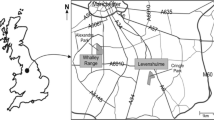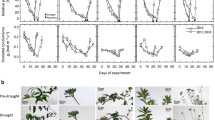Abstract
Key message
Tolerance and acclimation of photosynthesis to warmer growing conditions among nine urban tree species was species-specific indicating that individual screening is needed to prepare urban greenspace for a warmer future.
Abstract
To prepare and manage urban greenspace for a warmer future, we must select trees that can tolerate or acclimate to warmer growing conditions. Here, we compared tolerance and acclimation of photosynthesis to warmer growing conditions among urban trees species in Japan. Two paired experiments were installed where saplings of nine species were grown outside at two locations (warm- and cool-temperate climates) and in a greenhouse with and without passive warming. We compared the temperature where quantum yield declined to 50% of maximum value (T50) due to excess heat (50–60 °C) and the thermal optimum for photosynthesis (Topt) among species. For two deciduous and three evergreen species, T50 was higher for saplings grown in warm- than cool-temperate climate. T50 was also higher under passive warming for three species, of which two evergreen species (Morella rubra, Quercus myrsinifolia) showed marked increases (5–7 °C). Topt was higher under passive warming in three of six species examined, but the acclimation response of photosynthesis and stomatal conductance to warming was highly species-specific. We inferred that M. rubra and Q. myrsinifolia, which acclimated consistently to warmer growing conditions in both experiments, are heat-hardy species. Our results also suggest warm-temperate evergreen species are not necessarily more tolerant of warmer growing conditions than cool-temperate deciduous species. For example, despite its warm-temperate origin, Machilus thumbergii showed no acclimation response and photosynthetic rates were lower under passive warming. Our results indicate species need to be screened individually to assess their physiological tolerance and acclimation potential to warmer climate.







Similar content being viewed by others
Availability of data and material (data transparency)
Data will be made available in a database at Kobe University.
References
Araki MG, Gyokusen K, Kajimoto T (2017) Vertical and seasonal variations in temperature responses of leaf respiration in a Chamaecyparis obtusa canopy. Tree Physiol 37:1269–1284
Atkin OK, Tjoelker MG (2003) Thermal acclimation and the dynamic response of plant respiration to temperature. Trends Plant Sci 8:343–351
Berry J, Bjorkman O (1980) Photosynthetic response and adaptation to temperature in higher plants. Ann Rev Plant Physiol 31:491–543
Caplan JS, Galanti RC, Olshevski S, Eisenman SW (2019) Water relations of street trees in green infrastructure tree trench systems. Urban Forestry Urban Green 41:170–178. https://doi.org/10.1016/j.ufug.2019.03.016
Carnicer J, Coll M, Ninyerola M, Pons X, Sánchez G, Peñuelas J (2011) Widespread crown condition decline, food web disruption, and amplified tree mortality with increased climate change-type drought. Proc Nation Acad Sci 108:1474–1478
Carter KR, Cavaleri MA (2018) Within-canopy experimental leaf warming induces photosynthetic decline instead of acclimation in two northern hardwood species. Front For Glob Change 1:11
Cheesman AW, Winte rK, (2013) Growth response and acclimation of CO2 exchange characteristics to elevated temperatures in tropical tree seedlings. J Experim Botany 64:3817–3828
Chen Y, Wang X, Jiang B, Wen Z, Yang N, Li L (2017) Tree survival and growth are impacted by increased surface temperature on paved land. Landsc Urban Plann 162:68–79. https://doi.org/10.1016/j.landurbplan.2017.02.001
Cleland EE, Chuine I, Menzel A, Mooney HA, Schwartz MD (2007) Shifting plant phenology in response to global change. Trends Ecol Evol 22:357–365
Colombo S, Timmer R (1992) Limits of tolerance to high temperatures causing direct and indirect damage to black spruce. Tree Physiol 11:95–104
Cunningham S, Read J (2002) Comparison of temperate and tropical rainforest tree species: photosynthetic responses to growth temperature. Oecologia 133:112–119
Demuzere M et al (2014) Mitigating and adapting to climate change: Multi-functional and multi-scale assessment of green urban infrastructure. J Environ Manage 146:107–115. https://doi.org/10.1016/j.jenvman.2014.07.025
Doughty CE (2011) An in situ leaf and branch warming experiment in the Amazon. Biotropica 43:658–665
Dusenge ME, Duarte AG, Way DA (2019) Plant carbon metabolism and climate change: elevated CO2 and temperature impacts on photosynthesis, photorespiration and respiration. New Phytol 221:32–49
Emmanuel R, Loconsole A (2015) Green infrastructure as an adaptation approach to tackling urban overheating in the Glasgow Clyde Valley Region UK. Landsc Urban Plann 138:71–86. https://doi.org/10.1016/j.landurbplan.2015.02.012
Gill SE, Handley JF, Ennos AR, Pauleit S (2007) Adapting cities for climate change: The role of the green infrastructure. Built Environm 33:115–133. https://doi.org/10.2148/benv.33.1.115
Hikosaka K, Ishikawa K, Borjigidai A, Muller O, Onoda Y (2006) Temperature acclimation of photosynthesis: mechanisms involved in the changes in temperature dependence of photosynthetic rate. J Experim Bot 57:291–302
Jump AS, Penuelas J (2005) Running to stand still: adaptation and the response of plants to rapid climate change. Ecol Lett 8:1010–1020
Jump AS, Matyas C, Penuelas J (2009) The altitude-for-latitude disparity in the range retractions of woody species. Trends Ecol Evol 24:694–701
Kumarathunge DP, Medlyn BE, Drake JE, Tjoelker MG (2019) Acclimation and adaptation components of the temperature dependence of plant photosynthesis at the global scale. New Phytol 222:768–784
Law R, Crafts-Brandner SJ (1999) Inhibition and acclimation of photosynthesis to heat stress is closely correlated with activation of ribulose-1,5-bisphosphate carboxylase/oxygenase. Plant Physiol 120:173–182
Lenoir J, Gégout JC, Marquet PA, de Ruffray P, Brisse H (2008) A significant upward shift in plant species optimum elevation during the 20th century. Science 320:1768–1771
Lombardozzi DL, Bonan GB, Smith NG, Dukes JS, Fisher RA (2015) Temperature acclimation of photosynthesis and respiration: a key uncertainty in the carbon cycle–climate feedback. Geophys Res Lett 42:8624–8631
McDowell N, Allen CD (2015) Darcy’s law predicts widespread forest mortality under climate warming Nature. Clim Change 5:669–672
McDowell N et al (2008) Mechanisms of plant survival and mortality during drought: why do some plants survive while others succumb to drought? New Phytol 178:719
Menzel A, Sparks TH, Estrella N, Roy DB (2006) Altered geographic and temporal variability in phenology in response to climate change. Glob Ecol Biogeogr 15:498–504
Millar CI, Stephenson NL, Stephens SL (2007) Climate change and forests of the future: Managing in the face of uncertainty. Ecol Appl 17:2145–2151
Nitschke CR, Nichols S, Allen K, Dobbs C, Livesley SJ, Baker PJ, Lynch Y (2017) The influence of climate and drought on urban tree growth in southeast Australia and the implications for future growth under climate change. Landsc Urban Plann 167:275–287. https://doi.org/10.1016/j.landurbplan.2017.06.012
Norton B et al (2013) Planning for a cooler future: green infrastructure to reduce urban heat. Victorian Centre for Climate Change Adaptation Research, Melbourne
O’Sullivan OS et al (2017) Thermal limits of leaf metabolism across biomes. Glob Change Biol 23:209–223. https://doi.org/10.1111/gcb.13477
Pachauri RK et al. (2014) Climate change 2014: Synthesis report. Contribution of working groups I, II and III to the fifth assessment report of the intergovernmental panel on climate change. IPCC, Geneva, Switzerland
Pallardy SG (2008) Physiology of woody plants, 3rd edn. Academic Press, San Diego
Pataki DE, McCarthy HR, Litvak E, Pincetl S (2011) Transpiration of urban forests in the Los Angeles metropolitan area. Ecol Appl 21:661–677
Perez TM, Stroud JT, Feeley KJ (2016) Themal trouble in the tropics. Science 351:1392–1393
Roy S, Davison A, Östberg J (2017) Pragmatic factors outweigh ecosystem service goals in street tree selection and planting in South-East Queensland cities. Urban Forestry Urban Green 21:166–174. https://doi.org/10.1016/j.ufug.2016.12.003
Sage RF, Kubien DS (2007) The temperature response of C3 and C4 photosynthesis. Plant Cell Environm 30:1086–1106
Sendall KM et al (2015) Acclimation of photosynthetic temperature optima of temperate and boreal tree species in response to experimental forest warming. Glob Change Biol 21:1342–1357
Sevanto S, McDowell N, Dickman LT, Pangle R, Pockman W (2014) How do trees die? A test of the hydraulic failure and carbon starvation hypotheses. Plant Cell Environm 37:153–161
Sharkey TD (2005) Effects of moderate heat stress on photosynthesis: importance of thylakoid reactions, rubisco deactivation, reactive oxygen species, and thermotolerance provided by isoprene Plant. Cell Environm 28:269–277
Slot M, Kitajima K (2015) General patterns of acclimation of leaf respiration to elevated temperatures across biomes and plant types. Oecologia 177:885–900
Slot M, Rey-Sánchez C, Gerber S, Lichstein JW, Winter K, Kitajima K (2014) Thermal acclimation of leaf respiration of tropical trees and lianas: Response to experimental canopy warming, and consequences for tropical forest carbon balance. Glob Change Biol 20:2915–2926
Thomas CD et al (2004) Extinction risk from climate change. Nature 427:145–148
Visser ME (2008) Keeping up with a warming world; assessing the rate of adaptation to climate change. Proce Royal Soc B Biolog Sci 275:649–659
Way DA, Yamori W (2014) Thermal acclimation of photosynthesis: On the importance of adjusting our definitions and accounting for thermal acclimation of respiration. Photosynth Res 119:89–100
Williams AP et al (2013) Temperature as a potent driver of regional forest drought stress and tree mortality. Nature 3:292–297
Yamori W, Hikosaka K, Way DA (2014) Temperature response of photosynthesis in C3, C4, and CAM plants: temperature acclimation and temperature adaptation. Photosynth Res 119:101–117
Zachos J, Pagani M, Sloan L, Thomas E, Billups K (2001) Trends, rhythms, and aberrations in global climate 65 Ma to present. Science 292:686–693
Acknowledgements
We thank Ms. H. Ishii, Ms. M. Hioki, Dr. K. Ohshiman and the staff of Sumitomo Forestry Co. Ltd. for assistance with the experiments, and K. Kuroda, W. Azuma and members of the Laboratory of Forest Resources, Kobe Univ. for guidance and advice during research.
Funding
This research was funded by a grant from Sumitomo Forestry Inc. to Kobe University.
Author information
Authors and Affiliations
Contributions
HI and SI conceived and designed the study. SI prepared the plant material and CH, SI, and HI made the measurements with assistance from MN and HK. MO helped with statistical analyses. HI wrote the paper and all co-authors have approved of the draft.
Corresponding author
Ethics declarations
Conflict of interest
None declared.
Additional information
Communicated by Buckeridge.
Publisher's Note
Springer Nature remains neutral with regard to jurisdictional claims in published maps and institutional affiliations.
Supplementary Information
Below is the link to the electronic supplementary material.
Rights and permissions
About this article
Cite this article
Hara, C., Inoue, S., Ishii, H.R. et al. Tolerance and acclimation of photosynthesis of nine urban tree species to warmer growing conditions. Trees 35, 1793–1806 (2021). https://doi.org/10.1007/s00468-021-02119-6
Received:
Accepted:
Published:
Issue Date:
DOI: https://doi.org/10.1007/s00468-021-02119-6




